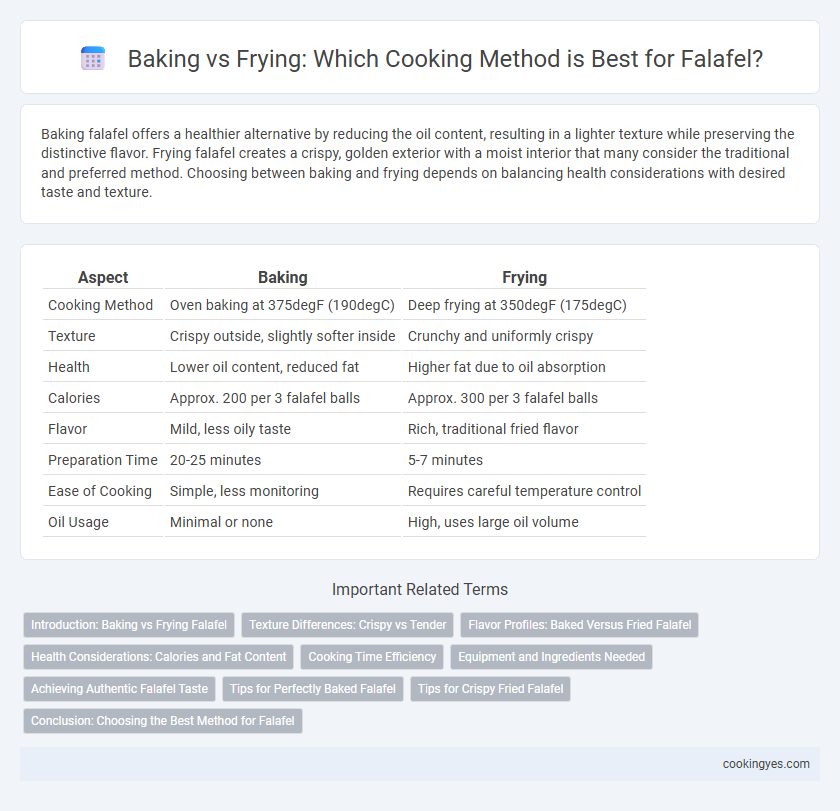Baking falafel offers a healthier alternative by reducing the oil content, resulting in a lighter texture while preserving the distinctive flavor. Frying falafel creates a crispy, golden exterior with a moist interior that many consider the traditional and preferred method. Choosing between baking and frying depends on balancing health considerations with desired taste and texture.
Table of Comparison
| Aspect | Baking | Frying |
|---|---|---|
| Cooking Method | Oven baking at 375degF (190degC) | Deep frying at 350degF (175degC) |
| Texture | Crispy outside, slightly softer inside | Crunchy and uniformly crispy |
| Health | Lower oil content, reduced fat | Higher fat due to oil absorption |
| Calories | Approx. 200 per 3 falafel balls | Approx. 300 per 3 falafel balls |
| Flavor | Mild, less oily taste | Rich, traditional fried flavor |
| Preparation Time | 20-25 minutes | 5-7 minutes |
| Ease of Cooking | Simple, less monitoring | Requires careful temperature control |
| Oil Usage | Minimal or none | High, uses large oil volume |
Introduction: Baking vs Frying Falafel
Baking falafel offers a healthier alternative by significantly reducing oil absorption while maintaining a crispy exterior and moist interior. Frying falafel enhances flavor through Maillard reaction, producing a golden-brown crust and a rich, traditional taste while adding more calories and fat content. Choosing between baking and frying depends on dietary preferences, texture expectations, and method convenience for preparing authentic Middle Eastern falafel.
Texture Differences: Crispy vs Tender
Baked falafel offers a tender interior and a slightly less crispy exterior, making it a healthier choice with reduced oil content. Fried falafel achieves a much crunchier and golden-brown crust, enhancing its traditional crispy texture that contrasts with the moist center. Choosing between baking and frying affects not only texture but also flavor intensity and calorie count.
Flavor Profiles: Baked Versus Fried Falafel
Baked falafel offers a milder, earthier flavor with a slightly drier texture, allowing the natural chickpea and herb notes to stand out. Fried falafel boasts a rich, crispy exterior and a moist, tender interior, enhanced by the deep-frying process that intensifies savory and aromatic spices. Both methods affect the flavor profile distinctly, with frying creating a more indulgent and crunchy bite compared to the lighter, health-conscious appeal of baked falafel.
Health Considerations: Calories and Fat Content
Baking falafel significantly reduces calorie and fat content compared to frying, as it uses minimal oil, cutting fat by up to 75%. Fried falafel often absorbs large amounts of oil, increasing calories and unhealthy trans fats, which can negatively impact heart health. Choosing baking as a cooking method supports a lower-calorie, heart-friendly diet while maintaining the savory flavor and crispy texture of traditional falafel.
Cooking Time Efficiency
Baking falafel typically requires 20-25 minutes at 375degF, offering a healthier option with less oil absorption but longer cooking time than frying. Frying falafel takes about 3-5 minutes in hot oil at 350degF, providing a crispy texture and faster cooking efficiency. Choosing frying over baking significantly reduces preparation time while maintaining traditional flavor and texture.
Equipment and Ingredients Needed
Baking falafel requires an oven preheated to 375degF and a baking sheet lined with parchment paper or a non-stick silicone mat, using minimal oil to achieve a crisp texture while preserving moisture. Frying falafel demands a deep fryer or heavy-bottomed skillet filled with vegetable or peanut oil heated to 350degF, ensuring even cooking and a golden, crunchy exterior. Key ingredients remain consistent for both methods, including soaked chickpeas, fresh herbs, garlic, and spices, but frying imparts a richer flavor due to oil absorption, whereas baking offers a healthier, lower-fat alternative.
Achieving Authentic Falafel Taste
Baking falafel results in a lighter texture with less oil absorption, but frying preserves the traditional crispy exterior and moist interior essential for authentic Middle Eastern flavor. Using high-quality chickpeas and properly ground spices enhances taste regardless of the cooking method chosen. Achieving the signature golden-brown crust and deep, savory flavor depends largely on frying at the correct temperature, typically around 350degF (175degC).
Tips for Perfectly Baked Falafel
Achieving perfectly baked falafel requires preheating the oven to 375degF and using a light coating of olive oil on the falafel balls to ensure a crispy exterior without excess oil absorption. Place the falafel on a parchment-lined baking sheet, spaced evenly to allow hot air circulation, and bake for 20-25 minutes, flipping halfway through for uniform browning. For ideal texture, incorporate chickpea flour or ground oats into the mixture to help bind and maintain moisture during baking.
Tips for Crispy Fried Falafel
For crispy fried falafel, maintain oil temperature between 350degF and 375degF to ensure even cooking and prevent sogginess. Use chickpeas soaked overnight, not canned, for better texture and hold the falafel mixture tightly before frying to avoid crumbling. Drain fried falafel on paper towels and serve immediately to preserve crispiness and enhance flavor.
Conclusion: Choosing the Best Method for Falafel
Baking falafel offers a healthier alternative by reducing oil content while maintaining a crispy exterior and tender interior. Frying ensures a traditional taste with a richer texture due to its deep-fried crust, but it increases calorie and fat intake. Selecting the best method depends on prioritizing health benefits or authentic flavor and texture preferences.
Baking vs Frying for Falafel Cooking Method Infographic

 cookingyes.com
cookingyes.com